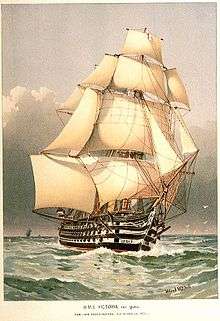HMS Victoria (1859)
 HMS Victoria (painting by William Frederick Mitchell, 265 mm x 189mm, collotype[1]) | |
| History | |
|---|---|
| Name: | HMS Victoria |
| Ordered: | 6 January 1855 |
| Laid down: | 1 April 1856 |
| Launched: | 12 November 1859 |
| Fate: | Sold for scrap, 31 May 1893 |
| General characteristics | |
| Displacement: | 6959 tons |
| Length: | 260 ft (79 m) |
| Beam: | 60 ft (18 m) |
| Draught: | 27 ft 6 in (8.38 m) |
| Propulsion: | Sails; 1 Maudslay engine fired by eight boilers, producing 4,403 ihp to one screw |
| Complement: | 1000 officers and men |
| Armament: | |
HMS Victoria was the last British wooden first-rate three-decked ship of the line commissioned for sea service.
With a displacement of 6,959 tons, she was the largest wooden battleship which ever entered service. She was also the world's largest warship until the completion of HMS Warrior, Britain's first ironclad battleship, in 1861.
Victoria's hull was 79.2 metres (260 ft) long and 18.3 metres (60 ft) wide. She had a medium draught of 8.4 metres (27.5 ft). Her hull was heavily strapped with diagonal iron riders for extra stability. Victoria was the first British battleship with two funnels.
She was armed with a total of 121 guns (32 8-inch smooth-bore muzzle-loading guns on the lower gun deck, 30 8-inch (200 mm) guns on the central gun deck, 32 32-pounders on the upper gun deck, 26 32-pounders and one 68-pounder on the upper deck).
Victoria was ordered on 6 January 1855, laid down on 1 April 1856 at Portsmouth, and launched on 12 November 1859. She cost a total of £150,578 (equivalent to £11,764,000 in 2010) and had a complement of 1,000.
During trials in Stokes Bay on 5 July 1860 Victoria reached a top speed of 11.797 knots (21.848 km/h),[2] making her the fastest three decker worldwide, along with the French "Bretagne". Her Maudslay engine was powered by 8 boilers and developed 4,403 ihp.
After completion Victoria was laid up as part of the reserve fleet at Portsmouth from 1860 to 1864.
She first entered active service on 2 November 1864, when she became Flagship of the Mediterranean fleet under Vice-Admiral Smart and Captain Goodenough (from 1865: Rear-Admiral Lord Clarence Paget, Captain Gardner). Victoria was based in Malta until 1867 when she returned home. Her armament had been reduced to 102 guns.
Her last public appearance came at the 1867 Spithead Review and she was paid off on 7 August 1867. She became part of the reserve fleet at Portsmouth again, eventually had her armament reduced to 12 guns, and was sold for scrapping on 31 May 1893 without ever having entered service again.
Victoria's slightly enlarged sister ship, HMS Howe, was launched on 7 March 1860, and achieved 13.565 knots (25.122 km/h) on her sea trials on 1 June 1861 (not masted or stored) for an engine power of 4,564 ihp,[2] but was never completed for sea as a line-of-battle ship. She first entered service in 1885 as a training ship at Plymouth, renamed Bulwark (6,557 tons, 12 Guns). She was moved to Devonport and renamed Impregnable in 1886. Renamed Bulwark again in 1919, she was finally sold for scrap in 1921.
References
Notes
- ↑ HMS Victoria 121 guns (The last three-decker-launched in 1859)
- 1 2 Lambert, "Battleships in Transition" p122.
Bibliography
- Andrew Lambert: "Battleships in Transition" (published by Conway Maritime Press Ltd, 1984), ISBN 0-85177-315-X
- NAVIES IN TRANSITION: The perfecting of the wooden man-of-war in the context of early 19th century international politics. A small guide to surviving and reconstructed 19th century warships from the pre-ironclad era in naval architecture. By Dirk J. Vries
- Battleships-Cruisers Naval History website.